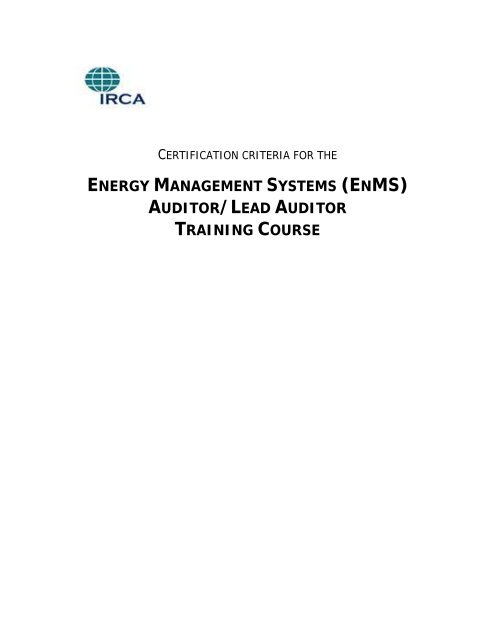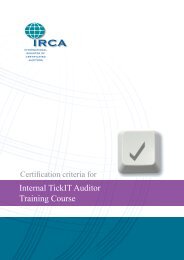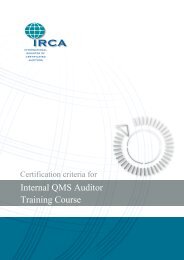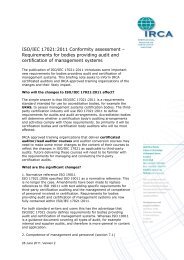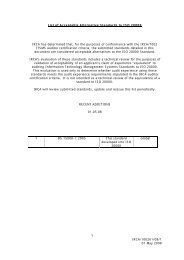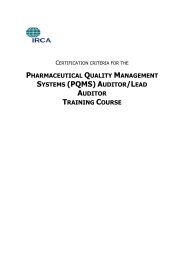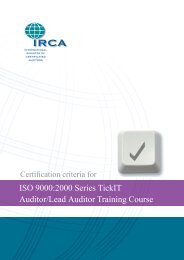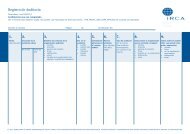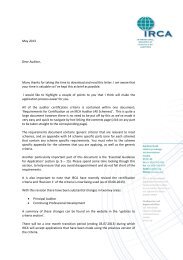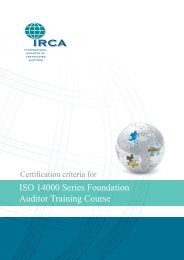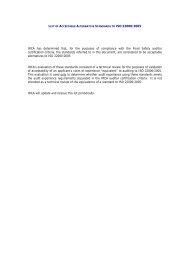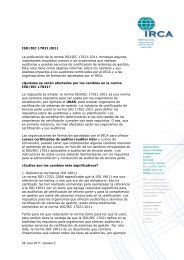ENERGY MANAGEMENT SYSTEMS (ENMS) AUDITOR ... - IRCA
ENERGY MANAGEMENT SYSTEMS (ENMS) AUDITOR ... - IRCA
ENERGY MANAGEMENT SYSTEMS (ENMS) AUDITOR ... - IRCA
Create successful ePaper yourself
Turn your PDF publications into a flip-book with our unique Google optimized e-Paper software.
CERTIFICATION CRITERIA FOR THE<br />
<strong>ENERGY</strong> <strong>MANAGEMENT</strong> <strong>SYSTEMS</strong> (<strong>ENMS</strong>)<br />
<strong>AUDITOR</strong>/LEAD <strong>AUDITOR</strong><br />
TRAINING COURSE
CERTIFICATION CRITERIA FOR <strong>ENERGY</strong> <strong>MANAGEMENT</strong> <strong>SYSTEMS</strong> (<strong>ENMS</strong>) <strong>AUDITOR</strong>/LEAD <strong>AUDITOR</strong> TRAINING COURSE<br />
CONTENTS<br />
1. INTRODUCTION<br />
2. LEARNING OBJECTIVES<br />
3. ENABLING OBJECTIVES – KNOWLEDGE & SKILLS<br />
4. TRAINING METHODS<br />
5. COURSE CONTENT<br />
6. COURSE DURATION<br />
7. TUTORS & STUDENTS<br />
8. VARIATIONS<br />
9. STUDENT ASSESSMENT & EXAMINATION<br />
10. COURSE PUBLICITY & ADVERTISING<br />
APPENDIX 1:<br />
NOTES FOR GUIDANCE<br />
Copyright <strong>IRCA</strong> – 2011<br />
All rights reserved. No part of this publication may be reproduced, stored in a retrieval system or transmitted in<br />
any form or by any means - electronic, mechanical, photocopying, recording or otherwise, without prior<br />
permission of the CQI International Register of Certificated Auditors (<strong>IRCA</strong>).<br />
Page 1 of 13<br />
<strong>IRCA</strong>/5001/11/01 July 2011
CERTIFICATION CRITERIA FOR <strong>ENMS</strong> <strong>AUDITOR</strong>/LEAD <strong>AUDITOR</strong> TRAINING COURSE<br />
1. INTRODUCTION<br />
1.1 We, the International Register of Certificated Auditors (<strong>IRCA</strong>), have prepared these criteria to<br />
help you, the approved training organization, to achieve certification of an Energy<br />
Management Systems (EnMS) Auditor/Lead Auditor training course.<br />
1.2 Before designing a EnMS Auditor/Lead Auditor training course to meet the requirements of this<br />
document you should consider the following:<br />
1.2.1 Aim of this course. The aim of this course is to provide students with the<br />
knowledge and skills required to perform first, second and third party audits of<br />
management systems against ISO 50001, in accordance with ISO 19011 and ISO<br />
17021, as applicable. All references in this document to ISO standards are to the<br />
current versions unless otherwise stated.<br />
1.2.2 EnMS Auditor certification. Students who successfully complete this EnMS<br />
Auditor/Lead Auditor course will satisfy the training requirements for initial<br />
certification as an <strong>IRCA</strong> EnMS Auditor (within the three years prior to making an<br />
application to become a certificated auditor).<br />
1.2.3 Prior knowledge. Before staring this course, you must inform students that they<br />
are advised to have the following prior knowledge:<br />
• Knowledge of the requirements of ISO 50001 and,<br />
• Knowledge of the following energy management principles and concepts:<br />
• the principles of fuel combustion, heat transfer and energy flow<br />
• the relevant sources of energy regulation, guidelines and standards<br />
• the typical methods and technologies for increasing efficiency<br />
• energy measurement units, sources, costs, tariffs and scheduling<br />
• energy use data analysis methods<br />
• energy performance indicators, monitoring and performance measurement<br />
• the impact of organisational processes and equipment on energy efficiency<br />
• electricity use: motors, drives, lighting, computers<br />
1.2.4 Flexibility in course design. These criteria specify the requirements for training<br />
courses including the knowledge and skills to be covered during the course. Your<br />
training course must be designed and delivered in accordance with these criteria,<br />
although you may exercise flexibility in the inclusion of additional material, and in the<br />
structure and selection of specific training methods used during the course. Many of<br />
the certification requirements common to the management and control of courses are<br />
detailed in <strong>IRCA</strong>/2000, Requirements for Training Organization approval. These<br />
requirements are in addition to the requirements of this document and are<br />
mandatory. It is essential, therefore, that you are familiar with the requirements of<br />
<strong>IRCA</strong>/2000.<br />
1.2.5 Training vs assessment. There must be two distinct aspects to courses based on<br />
these criteria:<br />
a) Effective training to help students develop the knowledge and skills defined in<br />
this document.<br />
b) Effective assessment of each individual student’s achievement of the knowledge<br />
and skills learning objectives through objective testing based on defined outputs.<br />
Page 2 of 13<br />
<strong>IRCA</strong>/5001/11/01 July 2011
CERTIFICATION CRITERIA FOR <strong>ENMS</strong> <strong>AUDITOR</strong>/LEAD <strong>AUDITOR</strong> TRAINING COURSE<br />
1.2.6 Training methods. This course may be designed to be presented in a variety of<br />
ways:<br />
2. LEARNING OBJECTIVES<br />
a) Classroom-based over 5 days full-time (i.e. over five consecutive working days).<br />
b) Classroom-based as a series of part-time modules over a longer period.<br />
c) Blended as a combination of self-study (i.e. e-learning course, correspondence<br />
course etc) and classroom-based learning.<br />
However it is designed, students must complete the whole course of study with your<br />
organization. Note: we will not accept courses that are wholly based on self-study<br />
learning.<br />
2.1 Learning objectives describe in outline what successful students will know and be able to do by<br />
the end of the course. By the end of the course successful students will be able to:<br />
Knowledge:<br />
2.1.1 Describe the purpose of: an energy management system, of energy management<br />
systems standards, of management system audit and of third party certification. (see<br />
3.1).<br />
2.1.2 Explain the role of an auditor to plan, conduct, report and follow up energy<br />
management system audit in accordance with ISO 19011 (and ISO 17021 where<br />
appropriate). (see 3.2).<br />
Skills:<br />
2.1.3 Plan, conduct, report and follow up an audit of an energy management systems to<br />
establish conformance (or otherwise) with ISO 50001 and in accordance with ISO<br />
19011 (and ISO 17021 where appropriate). (see 3.3).<br />
3. ENABLING OBJECTIVES – KNOWLEDGE & SKILLS<br />
In order for students to achieve the overall learning objectives, they will need to acquire and develop<br />
specific knowledge and skills. These are specified below as “enabling objectives” and can be<br />
considered as steps to the achievement of learning objectives.<br />
3.1 Describe the purpose of: an energy management system, of energy management<br />
systems standards, of management system audit and of third party certification.<br />
Knowledge:<br />
3.1.1 Explain the purpose of an energy management system and the business and<br />
environmental benefits of improving energy performance.<br />
3.1.2 With regard to ISO 50001:<br />
a) Explain Plan-Do-Check-Act framework.<br />
b) Explain the interrelationship between Management Responsibility, Energy Policy,<br />
Energy Planning, Implementation of Policy, Checking Performance, Management<br />
Review and Continual Improvement.<br />
c) Explain the terminology defined in the standard.<br />
d) Explain the difference between legal compliance and conformance with the<br />
standard.<br />
Page 3 of 13<br />
<strong>IRCA</strong>/5001/11/01 July 2011
CERTIFICATION CRITERIA FOR <strong>ENMS</strong> <strong>AUDITOR</strong>/LEAD <strong>AUDITOR</strong> TRAINING COURSE<br />
3.1.3 Explain the purpose of and differences between first-party, second-party and thirdparty<br />
certification audit of management systems, including the role of the EnMS<br />
auditor in assessing an organization’s capability to understand where and how energy<br />
is used and where the potential savings are.<br />
3.1.4 Explain the benefits of third-party accredited certification of energy management<br />
systems for organisations and stakeholders.<br />
3.2 Explain the role of an auditor to plan, conduct, report and follow up an energy<br />
management system audit in accordance with ISO 19011 (and ISO 17021 where<br />
appropriate).<br />
Knowledge<br />
3.2.1 Audit Process<br />
Explain the audit process, making reference to similarities and differences in the<br />
process between first-party, second-party and third-party certification audit, including:<br />
a. Determining audit objectives, the purpose and significance of the audit scope and<br />
criteria<br />
b. Resourcing the audit, the importance of auditor and team competency and the<br />
selection of team members, particularly with regard to knowledge of the relevant<br />
industry, regulations and legislation and auditor training<br />
c. The purpose of a stage 1 audit, including the documentation review, and describe<br />
a typical stage 1 audit process and outputs<br />
d. Preparing for a stage 2 audit, including preparing an audit plan<br />
e. Conducting on-site audit activities, including preparing working documents,<br />
gathering audit evidence, preparing and approving and distributing the audit<br />
report, conducting audit follow up.<br />
3.2.2 Auditor responsibilities<br />
a) Describe the roles and responsibilities of the client, auditors, lead auditors, guides<br />
and observers.<br />
b) Explain the management responsibilities of the lead auditor in managing the<br />
audit and the audit team.<br />
c) Explain the need for effective communication with the auditee throughout the<br />
audit process.<br />
d) Explain the need for auditor confidentiality.<br />
e) Outline the content and intent of the <strong>IRCA</strong> code of conduct.<br />
3.3 Plan, conduct, report and follow up an audit of an energy management system to<br />
establish conformance (or otherwise) against ISO 50001 and in accordance with<br />
ISO 19011 (and ISO 17021 where appropriate).<br />
Skills (to be practised and tested through tasks and in real or simulated audit<br />
situations).<br />
3.3.1 Planning the audit<br />
a) Establish that the scope, objectives, criteria, duration and resources for an audit<br />
are appropriate.<br />
b) Prepare an on-site audit plan that is appropriate to the above and the<br />
organization's context and processes.<br />
c) Prepare the necessary work documents, such as an audit checklist, sampling plan<br />
and forms.<br />
Page 4 of 13<br />
<strong>IRCA</strong>/5001/11/01 July 2011
CERTIFICATION CRITERIA FOR <strong>ENMS</strong> <strong>AUDITOR</strong>/LEAD <strong>AUDITOR</strong> TRAINING COURSE<br />
3.3.2 Conducting the audit<br />
a) Demonstrate the ability to manage opening meetings effectively.<br />
b) Demonstrate the ability to implement the audit plan, use work documents and to<br />
follow audit trails.<br />
c) Demonstrate the ability to build rapport with the auditee during the audit,<br />
including sensitivity to the needs and expectations of the auditee<br />
d) Demonstrate the ability to manage audit interviews effectively, including the<br />
ability to formulate effective audit questions.<br />
e) Demonstrate the ability to collect and verify appropriate audit evidence, including<br />
appropriate sampling (see 3.3.3)<br />
3.3.3 Auditing Energy Management System Requirements (see Appendix 1 for<br />
guidance)<br />
a) Evaluate the auditee’s energy management Policy and Objectives: established<br />
by management to reflect the nature and scale of the organisation;<br />
communicated by management; responsibility and authority for achieving policy<br />
and objectives have been established through adequate competent resources.<br />
b) Evaluate the auditee’s Energy Review including:<br />
o The complete identification of current energy sources; correct evaluation<br />
of past and present energy use and consumption; appropriate estimate of<br />
future energy use and consumption.<br />
o The correct identification of all significant energy use and consumption,<br />
including effectiveness of methods to identify and address variables and<br />
to identify current performance.<br />
o Effectiveness of methods for both the identification and prioritisation of<br />
performance improvement opportunities.<br />
o Effectiveness of methods for addressing currency of Energy Review in<br />
response to organisational change.<br />
o Identification of personnel who significantly impact on energy use.<br />
c) Review the methodology and currency of the auditee’s Energy Baseline, taking<br />
into account adjustments required from relevant changes within the<br />
organisation.<br />
d) Review the auditee’s Energy Performance Indicators: including the<br />
effectiveness of the methods to determine and adapt these, and appropriateness<br />
of the indicators for monitoring and measuring energy performance.<br />
e) Evaluate consistency of energy management Objectives and Targets with the<br />
Energy Policy; Legal and Other Requirements; the priorities established in the<br />
Energy Review.<br />
f) Evaluate the effectiveness of Action Plans in meeting energy Objectives and<br />
Targets.<br />
g) Verify that Operational Controls for those operations associated with<br />
significant energy uses are established, where the absence could lead to<br />
significant deviation from energy performance.<br />
h) Verify capability to plan for energy performance considerations in the Design of<br />
new, modified and renovated facilities, equipment, systems and processes.<br />
i) Verify the capability to plan for energy performance considerations in the<br />
Procurement of energy services, products equipment and energy.<br />
j) Evaluate the capability to identify compliance to relevant current and future<br />
Legal and Other Requirements.<br />
Page 5 of 13<br />
<strong>IRCA</strong>/5001/11/01 July 2011
CERTIFICATION CRITERIA FOR <strong>ENMS</strong> <strong>AUDITOR</strong>/LEAD <strong>AUDITOR</strong> TRAINING COURSE<br />
k) Review arrangements for monitoring and measuring significant energy use<br />
performance against policy and objectives, including requirements for internal<br />
audit.<br />
l) Evaluate the process of Management Review of the energy management<br />
Policy and Objectives based on measurement, analysis and improvement data,<br />
including audit outcomes, and outcomes which make improvements as required<br />
to policy, objectives, measures or the management system.<br />
m) Evaluate capability for Continual Improvement, including the effectiveness of<br />
methods for corrective and preventive action.<br />
3.3.4 Generating audit findings<br />
a) Demonstrate the ability to evaluate audit evidence to identify correctly<br />
conformance and non-conformance with requirements.<br />
b) Demonstrate the ability to prepare audit conclusions, including: the extent of<br />
conformity of the management system, identification of positive audit findings in<br />
addition to non-conformities, and identification of potential risks and opportunities<br />
for improvement.<br />
3.3.5 Reporting the Audit<br />
a) Write and grade non-conformity reports correctly.<br />
b) Present audit conclusions and recommendations clearly to the auditee at a<br />
closing meeting.<br />
3.3.6 Following up the audit<br />
a) Evaluate proposals for corrective action and differentiate between correction,<br />
corrective action and preventive action.<br />
4. TRAINING METHODS<br />
4.1 Your course may be presented as a wholly classroom-based course or as a blended course (in<br />
other words part self-study and part classroom-based). You may also present the course as a<br />
series of separate modules, either as full-time or part-time study.<br />
4.2 Classroom-based training<br />
4.2.1 You must provide for students an environment conducive to effective<br />
learning. At the beginning of the course you must provide the students with a<br />
description of the learning objectives, course structure, format and programme,<br />
student responsibilities and the assessment processes and assessment criteria, and<br />
you must deal with any concerns or worries that students may have.<br />
4.2.2 Your course must be based on the learning cycle (see guidance in Appendix 1)<br />
and include opportunities for students to:<br />
i. Experience new ideas and skills. (Note that tutor-led slide presentations<br />
as a sole method to help students learn new knowledge is not<br />
acceptable).<br />
ii.<br />
iii.<br />
Reflect on their learning and identify strengths and weaknesses. (Note<br />
that your course must include methods for monitoring and providing time<br />
for tutors and students to review tasks and activities and each student’s<br />
achievement of the learning objectives).<br />
Address and improve on areas of weakness. (Note that your course must<br />
include provision for review and remedial work, and individual coaching,<br />
where necessary.)<br />
4.2.3 Your course must include a variety of learning methods to suit the range of<br />
learning styles (see guidance in Appendix 1).<br />
Page 6 of 13<br />
<strong>IRCA</strong>/5001/11/01 July 2011
CERTIFICATION CRITERIA FOR <strong>ENMS</strong> <strong>AUDITOR</strong>/LEAD <strong>AUDITOR</strong> TRAINING COURSE<br />
4.2.4 Your course must not rely on tutor presentations and tutor-led discussions to<br />
achieve knowledge-based learning objectives. We expect to see students<br />
learning these elements mostly through a process that requires them to complete<br />
a task or activities, often in teams, and to produce a defined output.<br />
4.2.5 All students must practise the skill-based learning objectives of the course<br />
(learning objective 2.1.3) through participation in appropriate tasks and activities<br />
(role play, simulation etc).<br />
4.2.6 Timekeeping, planning and programme management are essential elements in the<br />
performance of an audit and, although we recognise that effective training is<br />
responsive to students’ needs, deviations from the timetable must be managed so<br />
that all learning objectives are adequately covered and students are kept informed<br />
of significant changes to the programme.<br />
4.2.7 You must submit session plans or tutor notes for each individual training session.<br />
Session plans must specify:<br />
• Learning objectives and duration for the session.<br />
• Descriptions of the training method(s) sufficient to ensure tutors apply a<br />
clearly structured learning process.<br />
• Training aids, exercises, case studies and other activities designed to involve<br />
and engage students and enhance participation, or reference to them.<br />
• A description of any activities, their purpose and intended output, or<br />
reference to other documents containing this information, for example<br />
student exercise briefs. Session plans must clearly indicate where the use of<br />
an activity is optional.<br />
• Student evaluation methods that specify how each learning objective will be<br />
assessed and include documented criteria with performance standards for<br />
successful completion of the course, or reference to them.<br />
4.3 Blended courses (a combination of self-study, including electronic media, and classroombased<br />
learning)<br />
4.3.1 Only knowledge-based learning objectives 2.1.1 and 2.1.2 may be covered by selfstudy<br />
methods.<br />
4.3.2 Learning objective 2.1.3 (auditing skills) must be completed in a classroom<br />
environment in terms of practice and student assessment. See clause 4.2 of this<br />
document for requirements for the classroom element of blended learning courses.<br />
4.3.3 Training methods selected should seek to involve and engage students throughout<br />
the duration of the course. Simply providing students with a set of reading<br />
materials will not be acceptable. Your self-study materials must be designed<br />
around a clearly structured learning process with:<br />
• Theory.<br />
• Examples (scenarios, case studies etc).<br />
• Practice (activities, case studies, progress tests etc).<br />
• Feedback/self-assessment on activities and tests where relevant, to ensure<br />
students can self-assess their understanding and achievement of the learning<br />
objectives and identify any areas requiring further work.<br />
4.3.4 Self-study course materials must be clearly presented and structured for ease of<br />
use, with appropriate navigational aids. You must make the following clear to<br />
students to help them manage their learning:<br />
• The learning objectives for the overall self-study element of the course.<br />
• The learning objectives for each section within the course.<br />
Page 7 of 13<br />
<strong>IRCA</strong>/5001/11/01 July 2011
CERTIFICATION CRITERIA FOR <strong>ENMS</strong> <strong>AUDITOR</strong>/LEAD <strong>AUDITOR</strong> TRAINING COURSE<br />
• How the self-study element of the course links with the classroom<br />
component.<br />
• The structure and suggested or intended sequence of the materials.<br />
• Instructions for the students’ use of the materials, including realistic<br />
timescales.<br />
• Examples of typical documents, reports, forms etc.<br />
• How, when and how often students may contact tutors for help, guidance<br />
and feedback.<br />
• Methods for students to assess their learning and to seek timely feedback<br />
and coaching from the tutor(s).<br />
4.3.5 You must ensure that each student has timely access to a course tutor to answer<br />
questions and queries.<br />
Note: as a guide, a response to communications from students within 24 hours<br />
would be acceptable.<br />
5. COURSE CONTENT<br />
5.1 At the beginning of the course presentation you must provide the students with a description<br />
of the learning objectives, course format and programme, student responsibilities and student<br />
evaluation processes and criteria.<br />
5.2 You must ensure students secure a copy of ISO 50001 or you must provide them with a copy<br />
for self-study (if relevant) and for classroom-based elements of the course.<br />
5.3 The course must cover:<br />
5.3.1 All aspects defined in clause 2 learning objectives and amplified in clause 3 enabling<br />
objectives.<br />
5.3.2 Local requirements, culture, practices or approaches to auditing and the application of<br />
ISO 50001 as appropriate for each country in which the course is presented.<br />
5.4 The course must cover the benefits of certification as an EnMS auditor, including brief details<br />
of the <strong>IRCA</strong> EnMS auditor certification scheme, and provide students with details of how to<br />
contact <strong>IRCA</strong> and apply for certification (you may use <strong>IRCA</strong>/190 and <strong>IRCA</strong>/167 or equivalent for<br />
this).<br />
6. COURSE DURATION<br />
6.1 Classroom-based learning<br />
6.1.1 Where the course is wholly classroom-based, the total course must be at least 40<br />
hours net, calculated as detailed in <strong>IRCA</strong>/2000.<br />
6.1.2 This course may be presented over a minimum of 5 consecutive days full-time or on<br />
a part-time (modular) basis over a maximum of 8 weeks.<br />
Note: although not mandatory, we recommend that this course be residential if presented over<br />
5 consecutive days.<br />
6.2 Blended learning<br />
6.2.1 Elements of the courses that are delivered through self-study will allow students<br />
three times longer than classroom training (i.e. approximately 80 hours for learning<br />
objectives 2.1.1 – 2.1.2).<br />
6.2.2 The classroom element (i.e. the skills learning objective 2.1.3 as a minimum) must be<br />
timed to allow each student to practise and be assessed on the skills learning<br />
objective. The amount of time given to this classroom element will depend on the<br />
learning objectives being covered, however normally 60% (or 3 days, or 24 hours<br />
Page 8 of 13<br />
<strong>IRCA</strong>/5001/11/01 July 2011
CERTIFICATION CRITERIA FOR <strong>ENMS</strong> <strong>AUDITOR</strong>/LEAD <strong>AUDITOR</strong> TRAINING COURSE<br />
gross as calculated in <strong>IRCA</strong>/2000) duration will be devoted to classroom-based<br />
learning and assessment. Courses with a reduction in classroom time may be allowed<br />
if agreed in advance with <strong>IRCA</strong>. See the Appendix for guidance for instances where<br />
reduced classroom time may be allowed.<br />
6.2.3 Each student must complete both the self-study and the classroom part of the<br />
training course in no more than 90 days.<br />
6.2.4 Students must complete each element of blended courses in the correct sequence.<br />
For example, for courses with a self-study element that is followed by a classroom<br />
element the Training Organization must ensure that students who do not complete<br />
the self-study element of the course are not accepted on to the classroom-based<br />
element. You must have a process for recording and validating each student’s<br />
completion of each element of blended courses to ensure students complete the<br />
course in the correct order.<br />
6.3 Translators<br />
6.3.1 If the course is given through translators, the time must be increased as necessary to<br />
satisfy the learning objectives.<br />
7. TUTORS & STUDENTS<br />
7.1 Classroom-based learning<br />
7.1.1 The number of students per course shall not exceed 20, or be less than 4.<br />
7.1.2 When the number of students is 11-20, the course shall be run with two designated<br />
tutors, both of whom shall be present for the full duration of the course. At least one<br />
tutor shall satisfy the requirements for a lead tutor as stated in <strong>IRCA</strong>/2000. Additional<br />
resources or trainee tutors may be used for specific activities, However the two tutors<br />
remain responsible for the entire presentation.<br />
7.1.3 Where the number of students is 4 to 10 inclusive, the course may be run with one<br />
designated tutor, who shall be present for the full duration of the course. That tutor<br />
shall satisfy the requirements for a lead tutor.<br />
7.2 Self-study based learning<br />
7.2.1 Tutors who provide educational support on self-study elements of blended learning<br />
must be competent to operate any media required.<br />
7.3 All courses. Tutors for this course must demonstrate competence in key attributes:<br />
7.3.1 Competence in training; by satisfying the tutor or lead tutor requirements as<br />
appropriate (see <strong>IRCA</strong>/2000).<br />
7.3.2 Competence in auditing against ISO 50001; by demonstrating auditing competence as<br />
a currently certificated EnMS Lead Auditor for Lead Tutors (or EnMS Auditor for<br />
Tutors) as described in <strong>IRCA</strong>/5000 or meeting the requirements for such certification.<br />
7.3.3 Competence to deliver training and student assessment on your specific course.<br />
8. VARIATIONS<br />
8.1 Requests for variations to any of these criteria, or in respect of any special circumstances, will<br />
be considered for approval on written submission by the approved training organization to<br />
<strong>IRCA</strong>. Any such request shall be made immediately upon the reason for the variation request<br />
becoming apparent.<br />
8.2 We will consider the following when evaluating any request for variation:<br />
8.2.1 Reasons for the requested variation.<br />
Page 9 of 13<br />
<strong>IRCA</strong>/5001/11/01 July 2011
CERTIFICATION CRITERIA FOR <strong>ENMS</strong> <strong>AUDITOR</strong>/LEAD <strong>AUDITOR</strong> TRAINING COURSE<br />
8.2.2 Proposed modifications to the training.<br />
8.2.3 The impact on the learning and assessment processes and how this will be managed.<br />
9. STUDENT ASSESSMENT & EXAMINATION<br />
We regard the assessment and examination of students to be a very important part of this course.<br />
9.1 Successful completion: in order to satisfactorily complete the course each student must:<br />
9.1.1 Complete/attend all elements of the course.<br />
9.1.2 Pass the continuous assessment (focused on the 3 learning objectives).<br />
9.1.3 Pass the Written Examination (focused on the 3 learning objectives).<br />
Note that the written examination assumes students have the prior knowledge described in<br />
clause 1.2.3 above.<br />
9.2 Conduct and management of continuous assessment<br />
9.2.1 Students must demonstrate acceptable levels of performance in all 3 learning<br />
objectives. During the course you must test each student's achievement of the<br />
learning objectives. These tests must be based on practical tasks and activities with<br />
defined outputs that students must produce.<br />
9.2.2 You must provide tutors with model outputs and a marking scheme/guidance to<br />
assess each student's performance and outputs.<br />
9.2.3 Tutors must provide students with feedback on their performance.<br />
9.2.4 Tutors must give further help and guidance to students who do not initially achieve<br />
elements of the learning objectives. They must provide these students with<br />
opportunities to complete further tasks to demonstrate competence.<br />
9.2.5 Each student’s achievement of learning objectives must be recorded on his/her<br />
continuous assessment record.<br />
Note: See the Appendix for guidance on continuous assessment.<br />
9.3 Conduct and management of the written EnMS auditor/lead auditor examination.<br />
9.3.1 <strong>IRCA</strong> courses: students must sit one of the current issue of <strong>IRCA</strong> set EnMS<br />
auditor/lead auditor examination papers.<br />
9.3.2 <strong>IRCA</strong> examinations must be conducted in accordance with the criteria set out in<br />
<strong>IRCA</strong>/2000.<br />
9.3.3 <strong>IRCA</strong> examination papers must state on every page:<br />
“<strong>IRCA</strong> EXAMINATION PAPER NUMBER [X]” amended for use on approved course<br />
[xxxx] operated by [TO], [the date of issue and page number].<br />
Please insert at X the <strong>IRCA</strong> reference number for the paper, at TO the name and<br />
<strong>IRCA</strong> certification number of your training organization and at xxxx the <strong>IRCA</strong><br />
certification number of your course.<br />
9.3.4 You may modify the <strong>IRCA</strong> examination papers as indicated below, but must not<br />
change the structure of the paper.<br />
a) Minor changes in the wording may be made to reflect local language<br />
differences.<br />
b) Changes in wording may be made to better reflect a specific context; e.g. a<br />
production or a retail application. These changes must NOT represent<br />
substantive changes to either the question or the solution.<br />
c) A maximum of 25% of each paper may be replaced but this must NOT<br />
change the structure of the paper. You must NOT make changes to section<br />
4 except to make a change of context or to remove the requirement to<br />
Page 10 of 13<br />
<strong>IRCA</strong>/5001/11/01 July 2011
CERTIFICATION CRITERIA FOR <strong>ENMS</strong> <strong>AUDITOR</strong>/LEAD <strong>AUDITOR</strong> TRAINING COURSE<br />
categorize the non-conformity as major or minor, in which case the<br />
categories should also be removed from the typical solutions. The NCR<br />
form may be replaced by a similar form, which you routinely use.<br />
d) On replacing a question, you must:<br />
- Provide a solution and marking scheme for the alternative question.<br />
- Send <strong>IRCA</strong> the alternative question (identifying clearly which question<br />
it is intended to replace) and its solution for approval before it is<br />
incorporated into the <strong>IRCA</strong> examination paper.<br />
10. COURSE PUBLICITY & ADVERTISING<br />
10.1 Course advertising and promotional literature shall not state or imply that this course satisfies<br />
more than the training requirements for certification as an <strong>IRCA</strong> EnMS Auditor.<br />
10.2 Prior to the commencement of the course, you must inform potential students that <strong>IRCA</strong><br />
recommends all students have the prior knowledge defined in clause 1.2.3.<br />
Page 11 of 13<br />
<strong>IRCA</strong>/5001/11/01 July 2011
CERTIFICATION CRITERIA FOR <strong>ENMS</strong> <strong>AUDITOR</strong>/LEAD <strong>AUDITOR</strong> TRAINING COURSE<br />
APPENDIX 1: NOTES FOR GUIDANCE<br />
1. Coverage of ISO 50001<br />
This course is designed for students who have an existing knowledge of energy management systems and ISO<br />
50001 and <strong>IRCA</strong> will not accept a clause-by-clause analysis of ISO 50001 in certified courses.<br />
This course does require students to assess an energy management system against the requirements of ISO<br />
50001, including the ability to identify audit evidence to establish conformance or non-conformance. This should<br />
be tested through tasks and in real or simulated audit situations.<br />
2. Meeting the learning and enabling objectives<br />
We do not expect courses to be designed in the chronological order of the learning and enabling objectives in<br />
this document. We recognise that individual sessions within a training course can cover more than one learning<br />
or enabling objective at the same time.<br />
You will need to demonstrate that your course gives students opportunity to audit an energy management<br />
system, covering the full scope of ISO 50001 and as described in enabling objective 3.3.3. We recognise it may<br />
not be practical for each student to audit all elements of ISO 50001. To meet the requirements of enabling<br />
objective 3.3.3 you should design audit activities so that individual and team activities collectively evaluate<br />
conformance (or otherwise) with all elements of ISO 50001. A contiguous case study approach is often the most<br />
effective means of covering the learning objectives, particularly those relating to the auditing of the EnMS<br />
processes referenced in 3.3.3. You should advise students that course examination questions can relate to any<br />
element of ISO 50001 and the required prior knowledge.<br />
3. Helping students learn new knowledge & skills<br />
We promote the use of participative learning approaches because they are more efficient, in terms of speed and<br />
depth of comprehension, and more effective, in terms of long term retention of new knowledge. Therefore, you<br />
should employ practical tasks and activities to help students to understand new concepts and ideas. You should<br />
not rely on tutor-focused lecture/presentation to transfer new ideas and concepts.<br />
We promote a variety of training methods in your course design. Different people learn in different ways so your<br />
sessions should follow the learning cycle and your course should include a variety of different learning activities<br />
to cater for all needs as far as possible. Honey and Mumford (Learning Style Questionnaire, Peter Honey<br />
Publications, ISBN 1 902899 07 5) provide one model for describing different learning styles that you may find<br />
useful as a basis.<br />
Continuous assessment should have a clear link between: session plans (for tutors), clear task/activity<br />
instructions with defined and measurable outputs (for students and tutors), activity marking schemes / model<br />
answers (for tutors), model answers (for students), individual student continuous assessment record (for<br />
recording student performance).<br />
4. Blended Learning – course duration & tutor:student ratios<br />
We will consider courses designed with less than 60% of the course duration (as calculated in <strong>IRCA</strong>/2000)<br />
devoted to classroom activity in circumstances where, for example, there is a smaller tutor:student ratio: for<br />
example 2 tutors and a maximum of 6 students.<br />
5. Self-Study<br />
We recommend that you consider the following documents when developing training based on information<br />
technology solutions:<br />
BS 7988:2002 A Code of Practice for the use of information technology for the delivery of assessments<br />
BS 8426:2003 A code of practice for e-support in e-learning systems<br />
Page 12 of 13<br />
<strong>IRCA</strong>/5001/11/01 July 2011


